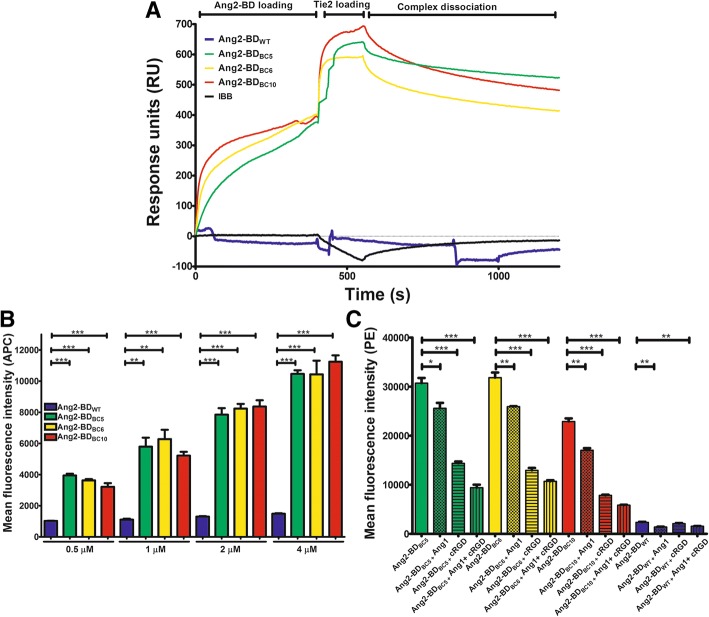Fig. 2.
Binding of Ang2-BD bi-specific variants to recombinant and cell-expressed human Tie2 and αvβ3 integrin. a Representative SPR sensorgram of Ang2-BD bi-specific variants (400 nM) binding to both αvβ3 integrin (immobilized) and soluble Tie2 (400 nM). Ang2-BD variants [Ang2-BDWT (blue), Ang2-BDBC5 (green), Ang2-BDBC6 (yellow), or Ang2-BDBC10 (red)] were allowed to flow for 400 s followed by an additional 150 s flow of Tie2. Injection of running buffer followed by rhTie2 in IBB served as negative control (black). Injection steps are indicated on the sensorgrams. b Binding of Ang2-BD bi-specific variants to TIME cells. 1 × 105 cells were incubated with Ang2-BDWT (blue), Ang2-BDBC5 (green), Ang2-BDBC6 (yellow), or Ang2-BDBC10 (red) for 2 h at 4 °C with gentle agitation. Mean fluorescence values were determined by flow cytometry using fluorescently labeled antibodies against a FLAG epitope tag. “*” indicates a P value < 0.05 by one-way ANOVA upon comparing results between Ang2-BD variants at the same concentration. c Competitive binding of 1 μM Ang2-BDWT (blue), Ang2-BDBC5 (green), Ang2-BDBC6 (yellow), or Ang2-BDBC10 (red), alone or with a combination of 1000 ng/ml of FL-Ang1 (checkered bars), 10 μM cRGD (horizontally lined bars) and both 1000 ng/ml FL-Ang1 and 10 μM cRGD (vertically-lined bars). Mean fluorescence values were determined by flow cytometry using fluorescently labeled antibodies against a FLAG epitope tag. “*” indicates a P value < 0.05 by one-way ANOVA upon comparing results between Ang2-BD variants alone and with FL-Ang1 and cRGD competitors. Data shown represent the average of triplicates from independent experiments, and error bars represent the standard error of the mean

